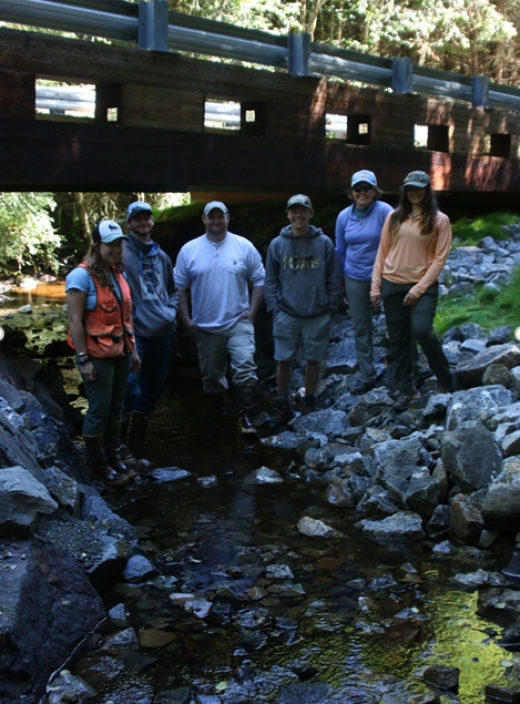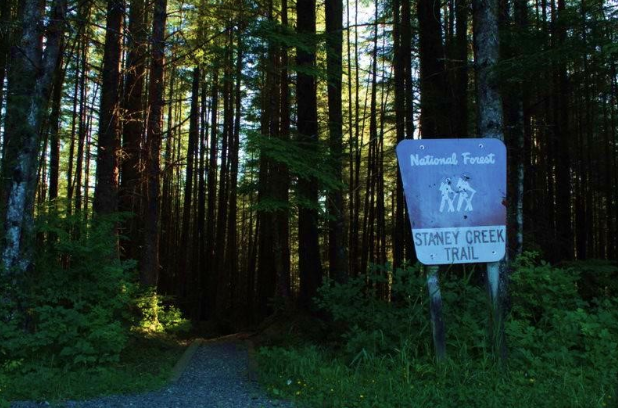The Staney Creek region of Prince of Wales Island holds 139,000 acres of Tongass National Forest wilderness. This temperate rainforest is the largest national forest in the country and holds a unique biodiversity rich with fish, terrestrial wildlife and forest vegetation. It also serves as means for tourist recreation, subsistence for the resource dependent communities nearby, and a commercial harvesting industry that fuels the local, state and national economy.
In 2004 the U.S. Forest Servicepartnered with the Tongass Nature Conservancy to stabilize Staney Creek habitats from past logging projects. Together, their efforts will save one of the most productive watersheds in southeast Alaska.
The goals of the Staney Creek projects are to enhance ecological conditions and maintain a functioning freshwater and terrestrial ecosystem. To make this happen, the Forest Service and TNC use a resource management assessment for the Staney watershed that covers key resource sectors including terrestrial and aquatic habitat, subsistence, timber supply and economics. If certain areas within the assessment are deficient, the team will collect data and implement an appropriate action plan that would stabilize the ecosystem over time.
By improving the project areas through continued management, enhancement and restoration, restoration efforts can attain a balanced ecosystem, recover the production of natural resources upon which people subsist, and increase the economic benefits from a sustainable and collaboratively managed landscape such as this.
Luckily, one of the projects they’ve been working on was completed just before the Five Rivers Odyssey team arrived to Prince of Wales Island, and they were super excited to show it to us. The two-week project involved the removal of an undersized stream culvert and replacing it with a bridge. This allows the stream to flow at a natural pace and create suitable habitat for fish to hold. Before the bridge was built, the culvert was essentially turning the stream into a firehose and was blasting everything out on the other side. If the stream bedrock gets blown out and large woody debris cannot hold its place, the salmon that are returning from the sea will not be able to reach their spawning beds.
 To improve this passage, fisheries and wildlife biologists hand-picked rocks to line the edges of the stream, secured in large woody debris to reduce the total energy of the system, and planted grass seed to help filter sediment from the water. As we stood admiring their work, spunky little fry swam around their new deep wooded pools with bliss.
To improve this passage, fisheries and wildlife biologists hand-picked rocks to line the edges of the stream, secured in large woody debris to reduce the total energy of the system, and planted grass seed to help filter sediment from the water. As we stood admiring their work, spunky little fry swam around their new deep wooded pools with bliss.
We were so inspired and ready to see more projects. We followed the lead biologists deeper into the woods to check out a long-term monitoring project of management indicator species happening on a tiny tributary of Staney Creek. Here we saw how they used 20 minnow traps to gather salmon fry and collect data. First they bait the minnow traps spread across a 120-meter stretch with salmon eggs to attract the fry. The traps sit for 90 minutes at a time and are reset three times a day. They measure, weigh and record the species of each individual fry before returning them back to their homes. Other management practices here included habitat surveys to count pools, riffles and large woody debris; cross section surveys to measure width to depth ratio in which they compare to unmanaged streams; and placement of rocks along riparian zones to reduce erosion and sedimentation.
By keeping records of species growth and increasing complexity to the Staney Creek habitats, we can ensure a strong future for our fishy friends.



